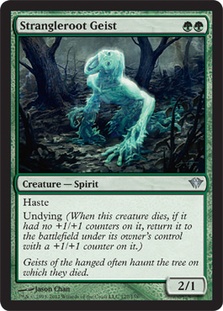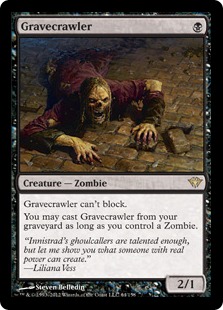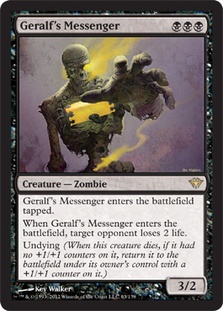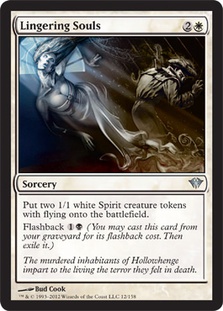Hey everyone!
At the time that I’m writing this, the Dark Ascension spoiler has only been half revealed, but already there are several powerful new cards that are sure to shake up Standard, going into Honolulu. Let’s start at the start with:
Occasionally Wizards prints a creature that is way above the curve, like Tarmogoyf, but in a way that’s not immediately obvious; everyone knew Tarmogoyf was going to be good when it was released, but few realized just how good. Strangleroot Geist is a terrible example of this because it’s clear from looking at it for two seconds that it just blows every other green two-drop out of the water. Is it on Tarmogoyf’s level? Probably not, but it’s not all that far off; it’s easily on Snapcaster Mage’s level, for example.
Let’s break it down. For two mana, you get a 2/1 haste, which is already on-curve (even slightly above), and it wouldn’t need a huge secondary ability to be playable in Constructed. And then it has undying, probably the single best creature keyword ability to be printed. Traditionally, if you start out with a Stromkirk Noble and have Incinerate up for their two-drop, you’re going to get through on turn 2. Traditionally, if you have Doom Blade up on turn 2, and they play a nonblack creature, you’re going to get to 1-for-1 them. Strangleroot Geist has roughly the same attitude towards tradition as Martin Luther. This guy is aggressively costed, trades positively with other creatures, trades positively with removal, and it even gets bigger—is this real? Even Dark Confidant and Tarmogoyf only ever went one-for-one with a Terminate.
Geralf’s Messenger has been touted as “the new Kitchen Finks,” but I think this card is actually much closer to Kitchen Finks, in terms of how broadly it will be played. Geralf’s Messenger is absurdly good, at least as powerful as either Strangleroot Geist or Finks, but the BBB cost is a huge restriction, and it’s very poor as a defensive creature. It brings heavy black aggro to life all by itself but won’t see play anywhere else; Finks, in contrast, was played in aggro, midrange, and control decks during its days in Standard, basically anything that could support its mana cost. Strangleroot Geist is much the same. For the next two years, if you’re playing a Standard deck that has Forests, it’s going to be really hard to justify not auto-including four of this guy.
In fact, Strangleroot Geist is good enough that paying three mana for him is still totally reasonable. That’s good news for Green Sun’s Zenith. In Standard, GSZ has traditionally been the versatile but slightly clunky card—it can be Primeval Titan, Dungrove Elder, Acidic Slime, or Birds of Paradise, but always a turn later than you’d really rather be casting them. With Strangleroot Geist, GSZ now has the main function of being Geists five through eight, with the added benefit of still being able to fetch any of the above cards. A lot of the time, Zenithing is not at all slower than casting Geist the old-fashioned way. Between Birds of Paradise and Llanowar Elves, green decks usually have three mana on turn 2 anyway.
G/R aggressive decks are already getting some airtime towards the end of this Standard season. Here’s a quick preview of how they might look next month:
Creatures (20)
- 4 Llanowar Elves
- 2 Birds of Paradise
- 1 Acidic Slime
- 1 Primeval Titan
- 1 Thrun, the Last Troll
- 2 Daybreak Ranger
- 4 Strangleroot Geist
- 3 Huntmaster of the Fells
- 2 Predator Ooze
Planeswalkers (3)
Lands (23)
Spells (14)

There are a couple other hits from Dark Ascension in this deck. Huntmaster of the Fells has gotten a lot of press, and for good reason. It’s not absurd or anything—transforming things isn’t easy in Constructed, given that skipping your turn runs the risk they’ll kill it on their upkeep. But four mana for four power and two life is already reasonable, and it has potential to singlehandedly dominate the game. In that way, it reminds me a lot of the good planeswalkers, like Ajani Vengeant or Garruk Relentless; it’s always going to be at least fine and sometimes totally insane. Fun fact: thanks to active player/nonactive player rules, when both players have a Huntmaster in play, they both really want to pass their turn (of course, one player having an Incinerate will blow this out of the water).
Predator Ooze is a card I like, and it’s very comparable to Dungrove Elder, so we’ll start with that. Like Dungrove Elder, Ooze is a green three-drop that’s resistant to creature removal. Like Dungrove Elder, Ooze gets very big, very fast, and is hard to profitably block or otherwise deal with. The problem with Dungrove Elder is that it severely restricts your manabase—you really have to be running like 18-20 Forests to get full value out of it, which means you can’t play any nongreen colored cards. Primeval Ooze still restricts your manabase, but in this case you only have to be running 18-20 green sources, which is very different. The deck above plays 11 red sources alongside two Birds of Paradise and still has ample ways to cast Ooze on turn 2 or 3.
The main weakness of Ooze (that Dungrove Elder doesn’t share) is Vapor Snag. That makes it a less than wonderful choice for the current metagame, but after the release of Dark Ascension, who knows what will happen? Maybe the Vapor Snag-Snapcaster decks will fall out of popularity, and sweepers a la Slagstorm will become bigger. Even if they don’t, Predator Ooze is powerful enough to make a splash. Whether it will be better than Daybreak Ranger is still up in the air (hence the 2-2 split); Ranger is much better against Delver and Moorland Haunt but worse everywhere else, even if it is much easier to cast.
Strangleroot Geist also fits perfectly in G/W Token strategies, which previously had a dearth of good two-drops:
Creatures (26)
- 4 Birds of Paradise
- 4 Hero of Bladehold
- 4 Blade Splicer
- 4 Avacyn's Pilgrim
- 3 Geist-Honored Monk
- 4 Strangleroot Geist
- 3 Thalia, Guardian of Thraben
Planeswalkers (6)
Lands (24)
Spells (4)

There is a bit of anti-synergy between Geist and Gavony Township, but the cards are good enough on their own that we can probably overlook that (besides, more than likely Geist will have died once by the time you want to activate your land). There is also anti-synergy between Thalia and, well, your own noncreature spells. It’s a little difficult to approach this because Thalia wants you to pack your deck full of creatures, but Day of Judgment existing makes that a dubious plan. This is a compromise, where Thalia will still hurt other decks a lot more than it hurts you, but if you don’t draw her, Garruk ensures you’re not totally cold to Day on turn 4.
Of course, the most obvious place for Thalia has got to be in U/W Humans. Doomed Traveler and Moorland Haunt already give you Wrath resilience, as does the newly spoiled Loyal Cathar, and she’s way better than any two-drop the deck was previously playing. It’s time to throw that Grand Abolisher nonsense out.
Creatures (29)
- 4 Mirran Crusader
- 4 Hero of Bladehold
- 1 Gideon's Lawkeeper
- 3 Fiend Hunter
- 4 Champion of the Parish
- 2 Geist of Saint Traft
- 4 Doomed Traveler
- 3 Loyal Cathar
- 4 Thalia, Guardian of Thraben
Lands (24)
Spells (7)

Champion of the Parish into Thalia is a devastating start for any control deck, particularly if you’re on the play. Since it slows them down by a full turn, it’s like you just cast Time Walk attached to a 2/1 first striking body. I think Thalia is going to significantly weaken decks along the lines of Esper or U/B Control, and it’s pretty insane against Gitaxian Probe, Ponder, Snapcaster Mage, and Midnight Haunting out of the Delver decks, too.
It seems like I’ve reached the end of smooth segues into talking about the next card, given this deck doesn’t have anything from Dark Ascension other than Thalia and the fairly boring-if-playable Doomed Traveler-esque Loyal Cathar. That sounds like a grave problem, certainly not something to crawl around. There’s definitely a message here, and it just might come from Geralf.
I’m going to talk about these two together because in future Standard they’re going to be quite the cute couple (insofar as you can really call a pair of Zombies a “cute couple”). Both of them are very aggressively costed beatsticks, resilient to removal, and they make each other much better. They’re also both terrible at blocking, so if you’re playing Zombies in this format, be prepared to turn things sideways early and often.
Looking at these two really hammers home how much better creatures have gotten over the course of Magic’s history. Jungle Lion was once considered a great one-drop; Gravecrawler is exactly Jungle Lion with a useful creature type and a ridiculous ability. As for Geralf’s Messenger, well, it seems pretty funny that Phyrexian Negator was once considered the pinnacle of black creature efficiency. This guy is arguably better than a 5/5 and doesn’t have all that extra depressing stuff about sacrificing permanents tacked on.
These guys are very difficult to beat permanently. If you block them, they come back. If you kill them, they come back. Geralf’s Messenger incidentally does you four while he’s at it, and Gravecrawler probably did that anyway in the first few turns. If Thalia was the white shroud of slow control decks, the Zombies are the nail in their coffin. Day of Judgment actually does nothing against a board of Geralf’s Messenger and Gravecrawler, other than put a +1/+1 counter on one of their creatures, which is not really what I want out of my four-mana spell.
Here’s a sample decklist:
That’s the build with Lashwrithe, which may or may not be good enough to justify being mono-Swamp. You could also touch blue for Snapcaster Mage and Mana Leak or red for Arc Trail and Incinerate, although Mountains and Islands are pretty bad at paying the fearsome BBBB. Nine maindeck removal spells is a lot, but this deck is weaker to opposing aggressive creatures than anything else. None of your creatures that cost less than four really block effectively, so you need to make sure you can win the race.
Finally, there’s this doozy:
Obviously this is inviting a lot of comparisons to Spectral Procession. In old Standard, Procession was a defining card; together with Windbrisk Heights and Ajani Goldmane, it made white the best midgame in town. Lingering Souls is very similar—I think even slightly better. It makes four tokens rather than three, and even though it’s more mana overall, it makes up for that by being awesome against counterspells and discard.
So the power level is there, but we need to see if we have the support as well. One thing that is definitely missing is the mana. Spectral Procession had the advantage of being in a format that had Caves of Koilos, Fetid Heath, and Arcane Sanctum as a W/B Coastal Tower, so casting both black and triple white spells in the same deck wasn’t a problem. Lingering Souls has just Isolated Chapel, and one dual is really never enough for a straight two-color deck to function. I suspect that white-black token decks in the upcoming Standard will be primarily white, with a black splash just for new Sorin and Lingering Souls flashback. It might be possible to get a little crazy and splash green for Gavony Township and Garruk Relentless; after all, you don’t need double of any color, and adding green gives you a lot more options for dual lands than black.
I built the wacky three-color deck to see what it looks like. After all, Patrick Chapin already did a great job discussing how the straight W/B Token deck would look on this very site.
Creatures (4)
Planeswalkers (11)
Lands (25)
Spells (20)

One thing we had in the days of Spectral Procession, and still do now, is a set of great Anthem effects. Back then, it was Glorious Anthem and Ajani Goldmane; these days, we can run Intangible Virtue, Gavony Township, and Sorin emblems. Intangible Virtue into Lingering Souls is just insane; that’s eight power for two cards! And you thought it was difficult to win off a mulligan to five. I opted not to run Honor of the Pure as well mostly because of its lack of synergy with Shrine and Sorin. The green splash gives us another, better, Anthem effect, which even taps to add mana in a pinch.
Here’s looking forward to the Prerelease. Standard is certainly not going to be the same.
Until next time,
Jeremy
tux_the_penguin on MTGO




